
Gentle readers,
It has become customary that after a Lumières event, a report is expected from me. Here it is.
It was our dear Kay who had found this event. A newly restored hunting castle was to be re-opened, and another nearby had its start-of-season celebration. Both had been built for Eugen of Savoyen, the famous warlord who had driven away the Turkish army from the gates of Vienna and was, therefore, treated as a national hero there. I guess I was almost due my own tally list (bit of an inside joke there, sorry) for complaining that nobody sung the Price Eugen Song. Both castles are located near the Danube floodplains east of Vienna, close to the Slovak border.
Somehow Kay had managed to persuade the managers (probably by talking to them at length and repeating himself a lot, as he is wont to do ;)) that they needed some authentically garbed people to enliven their events, and even wheedled a travelling cost allowance, a night's stay at a nearby B&B and alimentation out of them.
I arrived in Vienna, at Olivia's home, early Saturday afternoon. Kim arrived by train not much later. We had a wonderful dinner, cooked by Olivia, at her home. The next morning, we visited Schönbrunn palace but decided to forgo viewing the castle from within when we saw the queue that promised two hours' wait. We went to see the Mozart exhibition instead. If you, dear reader, are considering seeing that exhibit, I recommend reconsidering. Only a very dedicated Mozart fan may derive enough enjoyment from it to make up for the 10 Euro entrance fee.
Later that day, we left Vienna for a village in the Danube Floodplains National Park, close to the hunting castle, where we were to stay. We spent the evening at a place that is alternately called Heuriger or Buschnwirtschaft, i.e. a place that serves young (heurig=this year's) wine and cold food. This kind of pub is considered typical of Vienna and the surrounding wine-growing region. Unfortunately, they didn't serve the much coveted fried blood sausage. The publican asked us to sign his guest book ... It took us some time and a lot of giggling to think up a suitable entry. Later that evening, we were joined by Marion and Michael. Michael had only just come home from Boston that very morning.
The next morning, at 10, we went to Schloß Niederweiden to attend the re-opening. It's a small and rather plain hunting palace, so there was not much to do but stand around decoratively. Outside, it was cool and windy, but at least the rain was letting up. The following picture was taken in the upstairs room where the frescoes evoke a jungle.
After not quite 4 hours, we went on to Schloß Hof, a much larger building with agricultural buildings enclosed. We rode on a not-at-all-authentic carrriage and had lots of photos taken by tourists. Our strolls took us to the top terrace that looks out over the Danube plains and over to a suburb of Bratislave on the Slovak side. The lower terraces are still being restored. When they are, I don't doubt that they'll be able to compete with those at Sans Soucis in Potsdam.
The floodplains are well known for being a favourite nesting area of the stork, a bird that has become quite rare in most parts of Europe and faces extinction even now.. A couple of them nested on a smoke-stack that belonged to the castle. I'd never seen them outside a zoo before.
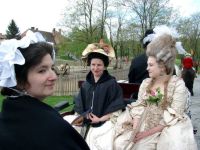 |
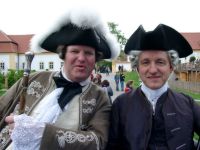 |
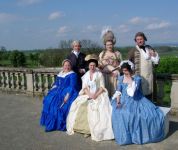 |
|
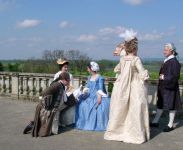 |
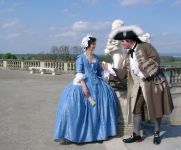 |
That night, we went back to the same pub as the night before and had more fun. The next morning, we took the scenic route back to Vienna, right through an asparagus-growing region, but missed buying asparagus fresh from the field. We all promised ourselves to buy some local asparagus in Vienna, though. On my insistence, we then visited a small business that is one of the last producers of gold and silver embroidery threads, spangles, purl, borders and so on. Apparently they're one of those small businesses that we costumers like to frequent, but that face extinction because their management fights off revenue as if it could bite.